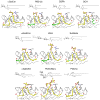NKT cell ligand recognition logic: molecular basis for a synaptic duet and transmission of inflammatory effectors
- PMID: 21772035
- PMCID: PMC3166221
- DOI: 10.4049/jimmunol.1001910
NKT cell ligand recognition logic: molecular basis for a synaptic duet and transmission of inflammatory effectors
Abstract
NKT cells that express the semi-invariant TCR are innate-like lymphocytes whose functions are regulated by self and foreign glycolipid ligands presented by the Ag-presenting, MHC class I-like molecule CD1d. Activation of NKT cells in vivo results in rapid release of copious amounts of effector cytokines and chemokines with which they regulate innate and adaptive immune responses to pathogens, certain types of cancers, and self-antigens. The nature of CD1d-restricted ligands, the manner in which they are recognized, and the unique effector functions of NKT cells suggest an immunoregulatory role for this T cell subset. Their ability to respond fast and our ability to steer NKT cell cytokine response to altered lipid ligands make them an important target for vaccine design and immunotherapies against autoimmune diseases. This review summarizes our current understanding of CD1d-restricted ligand recognition by NKT cells and how these innate-like lymphocytes regulate inflammation.
Figures




Similar articles
-
CD1d-restricted glycolipid antigens: presentation principles, recognition logic and functional consequences.Expert Rev Mol Med. 2008 Jul 7;10:e20. doi: 10.1017/S1462399408000732. Expert Rev Mol Med. 2008. PMID: 18601810 Review.
-
The Role of Adaptor Proteins in the Biology of Natural Killer T (NKT) Cells.Front Immunol. 2019 Jun 25;10:1449. doi: 10.3389/fimmu.2019.01449. eCollection 2019. Front Immunol. 2019. PMID: 31293596 Free PMC article. Review.
-
Type II NKT cells: a distinct CD1d-restricted immune regulatory NKT cell subset.Immunogenetics. 2016 Aug;68(8):665-76. doi: 10.1007/s00251-016-0930-1. Epub 2016 Jul 12. Immunogenetics. 2016. PMID: 27405300 Free PMC article. Review.
-
Interplay between carbohydrate and lipid in recognition of glycolipid antigens by natural killer T cells.Ann N Y Acad Sci. 2012 Apr;1253(1):68-79. doi: 10.1111/j.1749-6632.2011.06435.x. Epub 2012 Feb 21. Ann N Y Acad Sci. 2012. PMID: 22352829 Free PMC article. Review.
-
Defining a novel subset of CD1d-dependent type II natural killer T cells using natural killer cell-associated markers.Scand J Immunol. 2019 Sep;90(3):e12794. doi: 10.1111/sji.12794. Epub 2019 Jun 26. Scand J Immunol. 2019. PMID: 31141185 Free PMC article.
Cited by
-
Host immunomodulatory lipids created by symbionts from dietary amino acids.Nature. 2021 Dec;600(7888):302-307. doi: 10.1038/s41586-021-04083-0. Epub 2021 Nov 10. Nature. 2021. PMID: 34759313 Free PMC article.
-
Die Kämpfe únd schláchten-the struggles and battles of innate-like effector T lymphocytes with microbes.Front Immunol. 2023 Apr 24;14:1117825. doi: 10.3389/fimmu.2023.1117825. eCollection 2023. Front Immunol. 2023. PMID: 37168859 Free PMC article. Review.
-
Strategy of lipid recognition by invariant natural killer T cells: 'one for all and all for one'.Immunology. 2012 Jul;136(3):273-82. doi: 10.1111/j.1365-2567.2012.03580.x. Immunology. 2012. PMID: 22671023 Free PMC article. Review.
-
Natural killer T cells in advanced melanoma patients treated with tremelimumab.PLoS One. 2013 Oct 22;8(10):e76829. doi: 10.1371/journal.pone.0076829. eCollection 2013. PLoS One. 2013. PMID: 24167550 Free PMC article. Clinical Trial.
-
The molecular basis for recognition of CD1d/α-galactosylceramide by a human non-Vα24 T cell receptor.PLoS Biol. 2012;10(10):e1001412. doi: 10.1371/journal.pbio.1001412. Epub 2012 Oct 23. PLoS Biol. 2012. PMID: 23109910 Free PMC article.
References
-
- Medzhitov R. Origin and physiological roles of inflammation. Nature. 2008;454:428–435. - PubMed
-
- Bezbradica JS, Stanic AK, Matsuki N, Bour-Jordan H, Bluestone JA, Thomas JW, Unutmaz D, Van Kaer L, Joyce S. Distinct roles of dendritic cells and B cells in Va14Ja18 natural T cell activation in vivo. J Immunol. 2005;174:4696–4705. - PubMed
-
- Skold M, Xiong X, Illarionov PA, Besra GS, Behar SM. Interplay of cytokines and microbial signals in regulation of CD1d expression and NKT cell activation. J Immunol. 2005;175:3584–3593. - PubMed
-
- Winau F, Hegasy G, Weiskirchen R, Weber S, Cassan C, Sieling PA, Modlin RL, Liblau RS, Gressner AM, Kaufmann SH. Ito cells are liver-resident antigen-presenting cells for activating T cell responses. Immunity. 2007;26:117–129. - PubMed
Publication types
MeSH terms
Substances
Grants and funding
LinkOut - more resources
Full Text Sources
Other Literature Sources
Molecular Biology Databases
Research Materials

